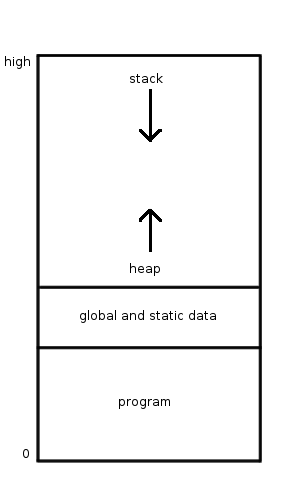|
Modula 2
Modula-2 is a structured, procedural programming language developed between 1977 and 1985/8 by Niklaus Wirth at ETH Zurich. It was created as the language for the operating system and application software of the Lilith personal workstation. It was later used for programming outside the context of the Lilith. Wirth viewed Modula-2 as a successor to his earlier programming languages Pascal and Modula. The main concepts are: # The module as a compiling unit for separate compiling # The coroutine as the basic building block for concurrent processes # Types and procedures that allow access to machine-specific data The language design was influenced by the Mesa language and the Xerox Alto, both from Xerox PARC, that Wirth saw during his 1976 sabbatical year there. Page 4. The computer magazine '' Byte'' devoted the August 1984 issue to the language and its surrounding environment. Modula-2 was followed by Modula-3, and later by the Oberon series of languages. Descript ... [...More Info...] [...Related Items...] OR: [Wikipedia] [Google] [Baidu] |
Imperative Programming
In computer science, imperative programming is a programming paradigm of software that uses statements that change a program's state. In much the same way that the imperative mood in natural languages expresses commands, an imperative program consists of commands for the computer to perform. Imperative programming focuses on describing ''how'' a program operates step by step, rather than on high-level descriptions of its expected results. The term is often used in contrast to declarative programming, which focuses on ''what'' the program should accomplish without specifying all the details of ''how'' the program should achieve the result. Imperative and procedural programming Procedural programming is a type of imperative programming in which the program is built from one or more procedures (also termed subroutines or functions). The terms are often used as synonyms, but the use of procedures has a dramatic effect on how imperative programs appear and how they are constructed ... [...More Info...] [...Related Items...] OR: [Wikipedia] [Google] [Baidu] |
Pascal (programming Language)
Pascal is an imperative and procedural programming language, designed by Niklaus Wirth as a small, efficient language intended to encourage good programming practices using structured programming and data structuring. It is named in honour of the French mathematician, philosopher and physicist Blaise Pascal. Pascal was developed on the pattern of the ALGOL 60 language. Wirth was involved in the process to improve the language as part of the ALGOL X efforts and proposed a version named ALGOL W. This was not accepted, and the ALGOL X process bogged down. In 1968, Wirth decided to abandon the ALGOL X process and further improve ALGOL W, releasing this as Pascal in 1970. On top of ALGOL's scalars and arrays, Pascal enables defining complex datatypes and building dynamic and recursive data structures such as lists, trees and graphs. Pascal has strong typing on all objects, which means that one type of data cannot be converted to or interpreted as another without explicit ... [...More Info...] [...Related Items...] OR: [Wikipedia] [Google] [Baidu] |
Application Software
Application may refer to: Mathematics and computing * Application software, computer software designed to help the user to perform specific tasks ** Application layer, an abstraction layer that specifies protocols and interface methods used in a communications network * Function application, in mathematics and computer science Processes and documents * Application for employment, a form or forms that an individual seeking employment must fill out * College application, the process by which prospective students apply for entry into a college or university * Patent application, a document filed at a patent office to support the grant of a patent Other uses * Application (virtue), a characteristic encapsulated in diligence * Topical application, the spreading or putting of medication to body surfaces See also * * Apply {{disambiguation ... [...More Info...] [...Related Items...] OR: [Wikipedia] [Google] [Baidu] |
Operating System
An operating system (OS) is system software that manages computer hardware, software resources, and provides common daemon (computing), services for computer programs. Time-sharing operating systems scheduler (computing), schedule tasks for efficient use of the system and may also include accounting software for cost allocation of Scheduling (computing), processor time, mass storage, printing, and other resources. For hardware functions such as input and output and memory allocation, the operating system acts as an intermediary between programs and the computer hardware, although the application code is usually executed directly by the hardware and frequently makes system calls to an OS function or is interrupted by it. Operating systems are found on many devices that contain a computer from cellular phones and video game consoles to web servers and supercomputers. The dominant general-purpose personal computer operating system is Microsoft Windows with a market share of aroun ... [...More Info...] [...Related Items...] OR: [Wikipedia] [Google] [Baidu] |
ETH Zurich
(colloquially) , former_name = eidgenössische polytechnische Schule , image = ETHZ.JPG , image_size = , established = , type = Public , budget = CHF 1.896 billion (2021) , rector = Günther Dissertori , president = Joël Mesot , academic_staff = 6,612 (including doctoral students, excluding 527 professors of all ranks, 34% female, 65% foreign nationals) (full-time equivalents 2021) , administrative_staff = 3,106 (40% female, 19% foreign nationals, full-time equivalents 2021) , students = 24,534 (headcount 2021, 33.3% female, 37% foreign nationals) , undergrad = 10,642 , postgrad = 8,299 , doctoral = 4,460 , other = 1,133 , address = Rämistrasse 101CH-8092 ZürichSwitzerland , city = Zürich , coor = , campus = Urban , language = German, English (Masters and upwards, sometimes Bachelor) , affiliations = CESAER, EUA, GlobalTech, IARU, IDEA League, UNITECH , website ethz.ch, colors = Black and White , logo = ETH Zürich Logo black.svg ETH Z� ... [...More Info...] [...Related Items...] OR: [Wikipedia] [Google] [Baidu] |
Programming Language
A programming language is a system of notation for writing computer programs. Most programming languages are text-based formal languages, but they may also be graphical. They are a kind of computer language. The description of a programming language is usually split into the two components of syntax (form) and semantics (meaning), which are usually defined by a formal language. Some languages are defined by a specification document (for example, the C programming language is specified by an ISO Standard) while other languages (such as Perl) have a dominant implementation that is treated as a reference. Some languages have both, with the basic language defined by a standard and extensions taken from the dominant implementation being common. Programming language theory is the subfield of computer science that studies the design, implementation, analysis, characterization, and classification of programming languages. Definitions There are many considerations when defining ... [...More Info...] [...Related Items...] OR: [Wikipedia] [Google] [Baidu] |
Zonnon
Zonnon is a general purpose programming language in the line or family of the preceding languages Pascal, Modula, and Oberon. Jürg Gutknecht is the author. Its conceptual model is based on objects, definitions, implementations, and modules. Its computing model is concurrent, based on active objects which interact via syntax controlled dialogs. The language is being developed at ETH Zürich Institute for Computer Systems by Professor Jürg Gutknecht. Zonnon introduces the concept of 'active objects' which are used to represent real world concurrent objects within computer programs. The Zonnon Language Report was written by Brian Kirk (director at Robinsons Associates), and David Lightfoot (Oxford Brookes University) working with Gutknecht (ETH, Zürich) and Dr. Eugene Zueff (Евгений Зуев) (Moscow State University). The first book about Zonnon was published by the N. I. Lobachevsky State University of Nizhny Novgorod (a.k.a., Nizhni Novgorod State University). [...More Info...] [...Related Items...] OR: [Wikipedia] [Google] [Baidu] |
Seed7
Seed7 is an extensible general-purpose programming language designed by Thomas Mertes. It is syntactically similar to Pascal and Ada. Along with many other features, it provides an extension mechanism.Daniel Zingaro"Modern Extensible Languages" SQRL Report 47 McMaster University (October 2007), page 16alternate link. Seed7 supports introducing new syntax elements and their semantics into the language, and allows new language constructs to be defined and written in Seed7. Abrial, Jean-Raymond and Glässer, Uwe"Rigorous Methods for Software Construction and Analysis" , Springer, 2010, page 166. For example, programmers can introduce syntax and semantics of new statements and user defined operator symbols. The implementation of Seed7 differs significantly from that of languages with hard-coded syntax and semantics. Features Seed7 supports the programming paradigms: imperative, object-oriented (OO), and generic. It also supports features such as call by name, multiple dispatch ... [...More Info...] [...Related Items...] OR: [Wikipedia] [Google] [Baidu] |
Lua (programming Language)
Lua ( ; from meaning ''moon'') is a lightweight, high-level, multi-paradigm programming language designed primarily for embedded use in applications. Lua is cross-platform, since the interpreter of compiled bytecode is written in ANSI C, and Lua has a relatively simple C API to embed it into applications. Lua originated in 1993 as a language for extending software applications to meet the increasing demand for customization at the time. It provided the basic facilities of most procedural programming languages, but more complicated or domain-specific features were not included; rather, it included mechanisms for extending the language, allowing programmers to implement such features. As Lua was intended to be a general embeddable extension language, the designers of Lua focused on improving its speed, portability, extensibility, and ease-of-use in development. History Lua was created in 1993 by Roberto Ierusalimschy, Luiz Henrique de Figueiredo, and Waldemar Celes, ... [...More Info...] [...Related Items...] OR: [Wikipedia] [Google] [Baidu] |
Ada (programming Language)
Ada is a structured, statically typed, imperative, and object-oriented high-level programming language, extended from Pascal and other languages. It has built-in language support for '' design by contract'' (DbC), extremely strong typing, explicit concurrency, tasks, synchronous message passing, protected objects, and non-determinism. Ada improves code safety and maintainability by using the compiler to find errors in favor of runtime errors. Ada is an international technical standard, jointly defined by the International Organization for Standardization (ISO), and the International Electrotechnical Commission (IEC). , the standard, called Ada 2012 informally, is ISO/IEC 8652:2012. Ada was originally designed by a team led by French computer scientist Jean Ichbiah of CII Honeywell Bull under contract to the United States Department of Defense (DoD) from 1977 to 1983 to supersede over 450 programming languages used by the DoD at that time. Ada was named after Ada Lovel ... [...More Info...] [...Related Items...] OR: [Wikipedia] [Google] [Baidu] |
Oberon (programming Language)
Oberon is a general-purpose programming language first published in 1987 by Niklaus Wirth and the latest member of the Wirthian family of ALGOL-like languages (Euler, ALGOL W, Pascal, Modula, and Modula-2). Oberon was the result of a concentrated effort to increase the power of Modula-2, the direct successor of Pascal, and simultaneously to reduce its complexity. Its principal new feature is the concept of type extension of record types. It permits constructing new data types on the basis of existing ones and to relate them, deviating from the dogma of strictly static typing of data. Type extension is Wirth's way of inheritance reflecting the viewpoint of the parent site. Oberon was developed as part of the implementation of an operating system, also named Oberon at ETH Zurich in Switzerland. The name is from the moon of the planet Uranus, named Oberon. Oberon is still maintained by Wirth and the latest Project Oberon compiler update is dated 6 March 2020. Design Oberon is de ... [...More Info...] [...Related Items...] OR: [Wikipedia] [Google] [Baidu] |




